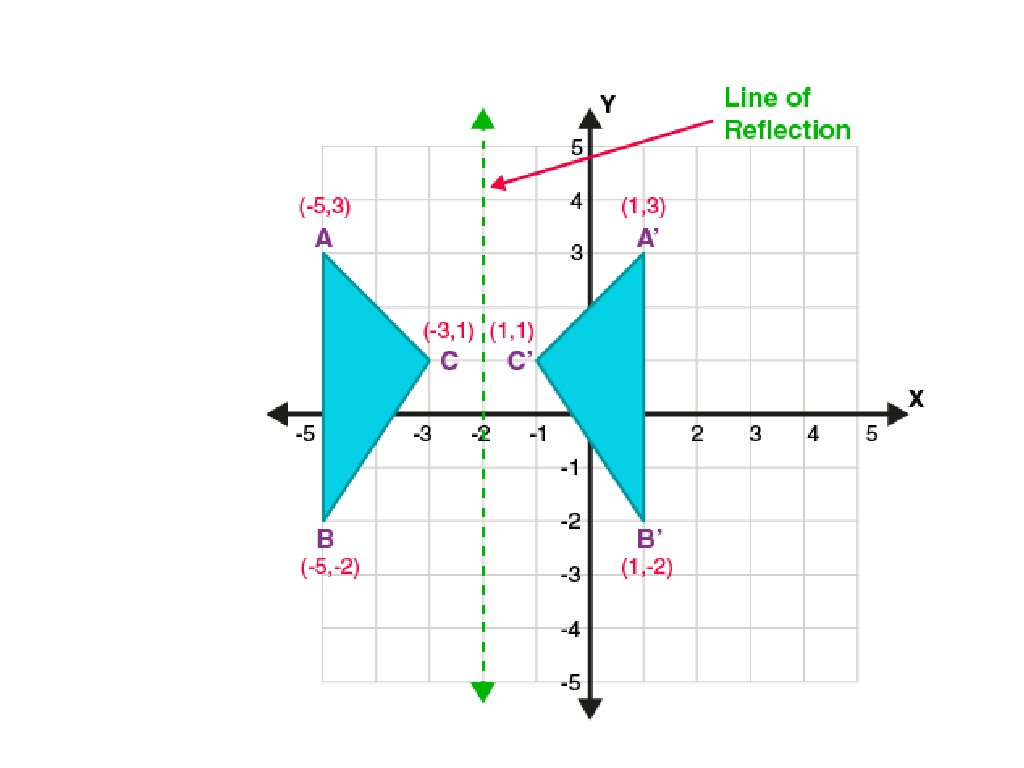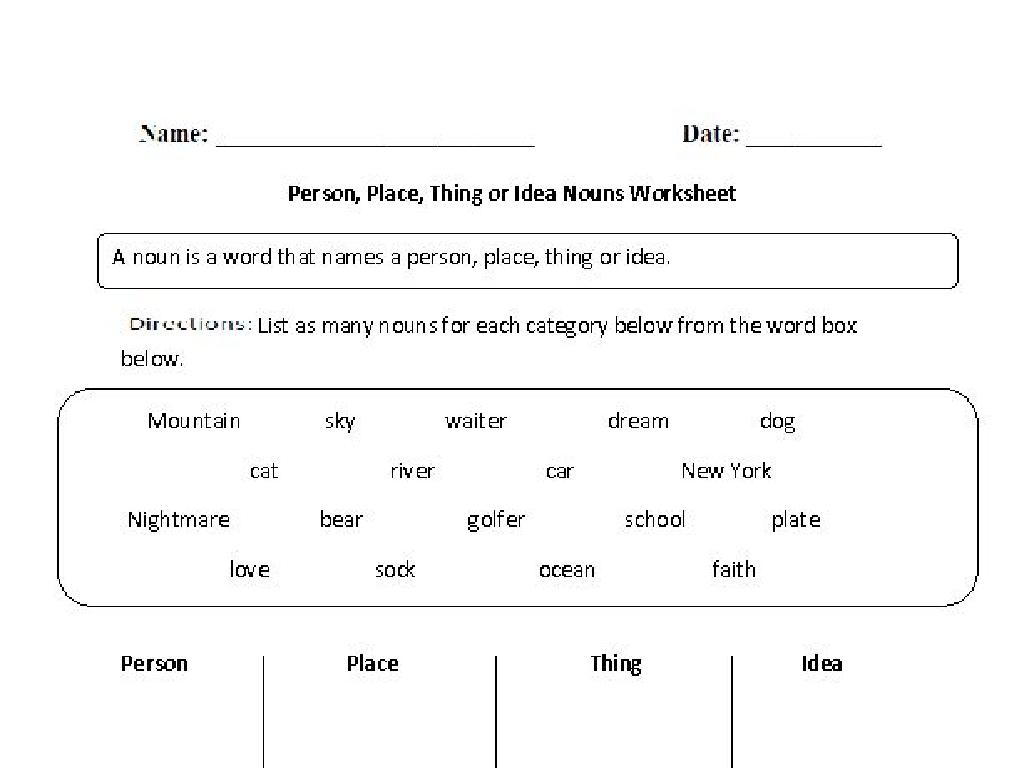Evaluate A Linear Function: Word Problems
Subject: Math
Grade: Eighth grade
Topic: Linear Functions
Please LOG IN to download the presentation. Access is available to registered users only.
View More Content
Evaluating Linear Functions in Word Problems
– Real-world application of linear functions
– Linear functions model constant rate changes, like speed or cost.
– Objective: Solve linear function problems
– Learn to identify variables and constants in problems.
– Steps to evaluate linear functions
– Identify the function, substitute values, and solve for the unknown.
– Practice with example word problems
– Use given scenarios to apply the steps and find solutions.
|
This slide introduces students to the concept of evaluating linear functions within the context of word problems, which is a critical skill in algebra. Emphasize the importance of understanding how linear functions represent real-world situations, such as rates of change. The objective is to equip students with the ability to identify the components of a linear function (variables, constants) and apply the correct operations to solve for unknown values. Provide a structured approach to tackling these problems: read the problem carefully, write down the function, substitute known values, and solve for the unknown. Encourage students to practice with various word problems to solidify their understanding. The notes should guide the teacher through the process of explaining these concepts and offer suggestions for example problems to work through as a class.
Understanding Linear Functions
– Define a linear function
– A function with a constant rate of change, represented by a straight line
– General form: y = mx + b
– ‘m’ is the slope, ‘b’ is the y-intercept
– Daily life function examples
– Mileage tracking: distance = rate x time + start point
– Graphing linear functions
– Plot points on a graph to visualize the function
|
Introduce the concept of linear functions by defining them as expressions with a constant rate of change, which graphically represent straight lines. Explain the slope-intercept form, where ‘m’ indicates the slope or steepness of the line, and ‘b’ represents the y-intercept, the point where the line crosses the y-axis. Provide relatable examples such as calculating mileage over time to illustrate how linear functions apply to everyday situations. Encourage students to think of other examples where they can see linear relationships. Conclude by showing how to graph these functions, emphasizing the importance of plotting points accurately to understand the function’s behavior.
Parts of a Linear Function
– Understanding the slope (m)
– Slope (m) indicates the rate of change; how steep the line is.
– Recognizing the y-intercept (b)
– Y-intercept (b) is where the line crosses the y-axis; the function’s starting value.
– Effects of ‘m’ and ‘b’ on the graph
– A larger ‘m’ means a steeper slope; ‘b’ shifts the line up or down.
– Interpreting linear functions
– Apply ‘m’ and ‘b’ to solve real-world problems with linear relationships.
|
This slide introduces the key components of a linear function, focusing on the slope and y-intercept. The slope, represented by ‘m’, describes how fast the function is changing, which translates to the steepness of the graphed line. The y-intercept, represented by ‘b’, indicates the point where the line crosses the y-axis, reflecting the starting value of the function. Understanding how ‘m’ and ‘b’ influence the graph helps students visualize linear relationships and solve word problems involving linear functions. Encourage students to practice by creating their own linear functions and graphing them to see the effects of different slopes and y-intercepts.
Evaluating Linear Functions: Word Problems
– Read the problem thoroughly
– Understand every detail and what is being asked.
– Identify variables and constants
– Determine what represents unknowns and fixed values.
– Translate words to expressions
– Convert the problem’s language into algebraic terms.
– Solve and check the equation
– Use the equation to find the solution and verify it.
|
This slide is aimed at guiding students through the process of solving word problems involving linear functions. Start by reading the problem carefully to understand the scenario and what is required. Next, identify the variables (unknowns) and constants (known values) within the problem. Then, translate the words into mathematical expressions, setting up an equation that represents the problem. Finally, solve the equation for the variables and check the solution by plugging it back into the original word problem. Encourage students to practice this process with various word problems to become proficient at evaluating linear functions in real-world contexts.
Real-World Application: Earnings Over Time
– Understanding job earnings
– Determine rate of pay (slope)
– The amount you earn per hour or per task
– Find initial earnings (y-intercept)
– Your earnings before starting the job, like a signing bonus
– Set up the linear function
– Use y = mx + b, where m is rate of pay, b is initial earnings
|
This slide aims to help students apply their understanding of linear functions to solve real-world problems, such as calculating earnings over time in a part-time job. Start by identifying the rate of pay, which represents the slope (m) in the linear function, indicating how earnings change over time. The initial earnings, or the y-intercept (b), represent the starting amount before any work is done. Students should then be able to set up the linear function using the formula y = mx + b, where y represents total earnings, m is the rate of pay, b is the initial earnings, and x is the number of hours or tasks completed. Encourage students to bring in examples of part-time jobs and calculate potential earnings as a class activity.
Evaluating Linear Functions: Word Problems
– Substitute values into the function
– Replace variables with given numbers from the problem
– Step-by-step calculation
– Follow mathematical operations in order
– Interpret the solution contextually
– Relate the answer back to the real-world scenario
– Example: School fundraiser
– If 5 tickets cost $40, find cost for 20 tickets using y = 8x
|
This slide is aimed at teaching students how to approach solving word problems that involve linear functions. Start by substituting the known values from the problem into the linear function. Then, guide students through the calculation process, ensuring they follow the correct order of operations. Once the calculation is complete, it’s crucial to interpret the result within the context of the problem to understand the real-world implications. For example, use a relatable scenario such as a school fundraiser where tickets are sold. If 5 tickets cost $40, and the cost is a linear function of the number of tickets, students can use the function y = 8x to find the cost of 20 tickets. This exercise will help students see the practical application of linear functions in everyday situations.
Evaluating Linear Functions: Practice Problems
– Calculate project supply costs
– Use the function to find total cost based on number of supplies
– Determine distance over time
– Apply the function to calculate distance for different time intervals
– Estimate plant growth weekly
– Predict the height of a plant using the growth rate function
|
This slide presents three practical problems for students to apply their knowledge of linear functions. For problem 1, provide a linear function that represents the cost of supplies as a function of the number of items purchased. Students will use this function to calculate the total cost for a given number of supplies. In problem 2, students will use a linear function that represents distance as a function of time to determine how far someone traveled during a trip at a constant speed. For problem 3, they will use a linear function to estimate the growth of a plant over several weeks, given its weekly growth rate. Encourage students to set up the appropriate linear function for each scenario and solve for the unknown variable. These problems will help solidify their understanding of how linear functions can be used to model and solve real-world situations.
Group Activity: Linear Function Word Problems
– Break into small groups
– Solve a practice problem
– Use given data to find the linear function
– Present problem and solution
– Explain steps taken to solve the problem
– Discuss various approaches
– Compare different methods used by groups
|
This group activity is designed to foster collaborative problem-solving skills among students. Each group will tackle a unique word problem involving linear functions, allowing them to apply their knowledge in a practical context. After solving their assigned problem, they will present their findings to the class, explaining the steps and reasoning behind their solution. This will be followed by a class discussion on the different approaches taken by each group, highlighting the diversity of problem-solving techniques and promoting a deeper understanding of linear functions. Teachers should prepare diverse problems of varying difficulty and ensure that each group understands their problem before beginning. During presentations, encourage active listening and constructive feedback. The goal is to enhance students’ abilities to evaluate linear functions through word problems and to articulate their thought processes.
Review & Reflection: Linear Functions
– Recap of linear functions
– Reviewed how to evaluate linear functions and solve word problems.
– Applying knowledge cross-discipline
– Discuss how linear functions relate to subjects like economics, physics, and coding.
– Identifying real-life applications
– Examples: budgeting with a fixed income, distance over time in travel.
– Addressing questions and clarifications
|
This slide aims to consolidate the day’s learning on linear functions, emphasizing their evaluation and application in word problems. Encourage students to reflect on how the concepts learned can be applied in various subjects such as economics (predicting profits/losses), physics (calculating speed or acceleration), and computer science (algorithms involving linear functions). Discuss real-life scenarios where linear functions are applicable, like planning a budget with a fixed weekly allowance or calculating travel time based on constant speed. Finally, open the floor for any questions to clarify doubts and ensure a strong understanding of the topic.
Homework: Mastering Linear Functions
– Complete the worksheet provided
– Solve each word problem, applying linear function concepts
– Create your own linear function problem
– Use a real-life scenario to formulate a problem
– Study for the upcoming quiz on linear functions
– Review notes, homework, and ask questions if needed
|
This homework assignment is designed to reinforce students’ understanding of linear functions through practice and application. The provided worksheet contains additional word problems that require students to evaluate linear functions. Encouraging students to create their own word problems will help them understand the practical applications of linear functions and enhance their problem-solving skills. To prepare for the quiz, students should review their class notes, previous homework assignments, and ensure they understand key concepts. Offer support by reminding them to reach out with any questions during the next class or via email. Provide a study guide if possible, and consider hosting a review session.





